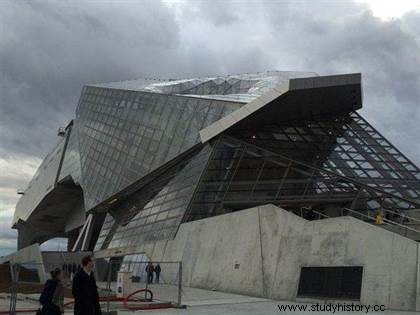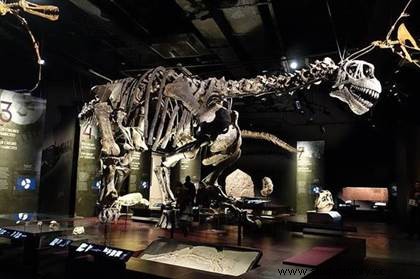 Since its opening in 2014, the Musée des Confluences in Lyons is always full, despite the controversy over its cost of construction and its "futuristic" appearance. With four rooms for permanent exhibitions and three inaugural temporary exhibitions, the museum has an atypical architecture.
Since its opening in 2014, the Musée des Confluences in Lyons is always full, despite the controversy over its cost of construction and its "futuristic" appearance. With four rooms for permanent exhibitions and three inaugural temporary exhibitions, the museum has an atypical architecture.
An Atypical Architecture
180 meters long, 90 wide and 45 high, this building is the first achievement in France of the Austrian architect firm COOP Himmelblau known for its deconstructivist achievements in Germany ( BMW Welt in Munich for example). This very complex building houses all the collections, permanent and temporary, over nearly 11,000 m² and four levels. Located at the confluence of the Rhône and the Saône, the museum is also a combination of three architectural units:the Crystal, the Cloud and the Base.
The base is the concrete part on which the Crystal and the Cloud rest. Designed on two semi-buried levels, it includes the 2 auditoriums, the reception of groups, the spaces that can be privatized and the technical spaces of the museum.
The Crystal is dedicated to public entrance and visitor circulation. It is mainly made with glass. The gravity well serves as a central support to support the metal structures and stabilizes the Crystal.
Finally, the Cloud houses all the exhibition rooms on four levels. This part consists of a metal structure.
To date, the public garden surrounding the museum is not yet finished, but when it is it will offer a zone of vegetation and walks that will certainly be very pleasant which, we hope, will make it possible to disregard the ring road located right next to the Museum.
The permanent exhibition
 The permanent route tells the great story of humanity through four rooms with distinct exhibits that describe and present the question of the origins and destiny of humanity, the diversity of cultures and civilizations, but also the place of Homo Sapiens in the chain of the Living. Organized according to four different scenographies, produced by three different scenographers, the museum reuses the collections of the Guimet Museum of Natural History in Lyon.
The permanent route tells the great story of humanity through four rooms with distinct exhibits that describe and present the question of the origins and destiny of humanity, the diversity of cultures and civilizations, but also the place of Homo Sapiens in the chain of the Living. Organized according to four different scenographies, produced by three different scenographers, the museum reuses the collections of the Guimet Museum of Natural History in Lyon.
Origins, the stories of the world:In this first space, you will go back in time to the origins of the universe and our world. You will first encounter the dinosaurs. Many skeletons of different species are exhibited in this space. Also set out to meet fossils and a few insects from the Guimet collection before going back in time to the Big Bang, thanks to a 3D film, and discovering objects as astonishing as pieces of the planet Mars or the Moon. The discovery of space, present in this place, also makes it possible to question the aboriginal societies on their conception of the universe.
 Species, the mesh of life:In this second room, visitors can discover or rediscover part of the great collection of stuffed animals from the Musée Guimet. Highlighted in a very playful way, these animals will delight the youngest and the oldest and give new life to these pieces which experienced a notable disavowal towards the end of the 20th century (see the article on Natural History Museums ).
Species, the mesh of life:In this second room, visitors can discover or rediscover part of the great collection of stuffed animals from the Musée Guimet. Highlighted in a very playful way, these animals will delight the youngest and the oldest and give new life to these pieces which experienced a notable disavowal towards the end of the 20th century (see the article on Natural History Museums ).
Society the theater of men:In this third stage, the museum and the scenography propose to question cultures and civilizations. The presence of technological innovations that have marked our societies such as the telephone, or the car, but also the historical forms of power with the Chinese dynasties or even very beautiful African shields. But civilization is also settling in a territory whose questioning passes through aboriginal paintings or photographs.
 Eternities, visions of the afterlife:In this last space, the museum questions beliefs about the 'beyond. To do this, the explanation of Egyptian or Inca funeral rites also makes it possible to understand the belief in ancestors still present today in African societies, for example. Many masks representing spirits or ancestors present here certainly come again from the Guimet collections, but the atmosphere created by this room is quite mysterious.
Eternities, visions of the afterlife:In this last space, the museum questions beliefs about the 'beyond. To do this, the explanation of Egyptian or Inca funeral rites also makes it possible to understand the belief in ancestors still present today in African societies, for example. Many masks representing spirits or ancestors present here certainly come again from the Guimet collections, but the atmosphere created by this room is quite mysterious.
More to note
At the moment and until July 2015, three inaugural temporary exhibitions are located on the first floor. The first two “Les Trésors d'Émile Guimet” and “Dans la Chambre des Merveilles” highlight the historical affiliation with the former Natural History Museum. The latest “Conquest of the South Pole” exhibition sheds light on the race towards the last great geographical reward of the 20th century and highlights the destiny of extraordinary men who surpassed themselves to pave the way for scientific research in Antarctica. More than just temporary exhibitions, these rooms are so rich that they could constitute a new museum space in their own right.
At the end of your visit, or simply to take a break, don't hesitate to climb to the very top of the museum, to the panoramic terrace which will give you an unobstructed view in Lyon and which also has a small snack bar for an even more pleasant break. Finally, go to the ground floor to enjoy the shop and restaurant of Jean-Paul Pignol, best worker in France, and Guy Lassausaie, 2 stars in the Michelin guide.
Our Opinion
 The Museum, in addition to being very original from an architectural point of view, has extremely interesting collections. The scenography allows an extremely playful approach which will delight young and old, but also people who are not too fond of museums. Some objects can be touched, the presence of 3D technology and touch screens in the rooms allow for an enriching and interactive visit. Finally, the collections are very well showcased and if the arrangement appears, at first glance, very original, it results from a multidisciplinary approach and an original presentation of the question of origins and civilizations.
The Museum, in addition to being very original from an architectural point of view, has extremely interesting collections. The scenography allows an extremely playful approach which will delight young and old, but also people who are not too fond of museums. Some objects can be touched, the presence of 3D technology and touch screens in the rooms allow for an enriching and interactive visit. Finally, the collections are very well showcased and if the arrangement appears, at first glance, very original, it results from a multidisciplinary approach and an original presentation of the question of origins and civilizations.
Practical info
Confluence Museum
86 Quai Perrache
69002 Lyon
Access:Tram T1 stop “Musée des Confluences”; buses C7, C10, 15, 63, 88; for cars paying parking "Tony Garnier".
Schedules:
Tuesday to Friday from 11 a.m. to 7 p.m.
Saturday and Sunday from 10 a.m. to 7 p.m.
Thursday night until 10 p.m.
Closed on Mondays and public holidays (January 1, May 1, November 1, December 25)
Prices:from €5 to €9 for access to all exhibitions, free admission possible (see criteria)
